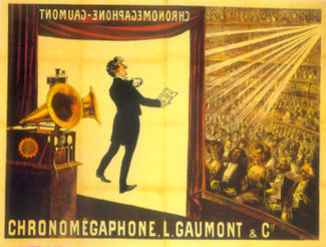Main Content
Lesson 2: The Development of Cinematic Language
Early Sound Recording


Sound was the natural innovation to come next. If the idea of art has always been to provide a mirror to nature, one of the things that people always wanted to do was to create a more complete picture of nature with sound.
During the first three decades of cinematic production, the medium was essentially a visual one. This is not to say that it was silent in the strictest sense, as movies often had orchestras giving you mood music or music to set emotional tone along with the background. There was no dialogue. There was no talking. The process of signification was essentially done with images. And technology changed all of this.
Synchronized sound was first exhibited as early as 1900 using phonographs that would be placed along with projectors. This was sometimes done in the early nickelodeon. But it would not be until the mid-1920s that it became a viable process that could be mechanically reproduced for dissemination to mass audiences and in essence where the sound could be put on the film itself.
Chaplin was the most famous star in the twenties, but he thought that talking would destroy the universal language of cinema, which in his mind was the way it rendered emotion through motion. Chaplin believed that instead of having images move across screen and things fly around, what you would have with talking pictures was shot and countershot between two people speaking dialogue. And, in many ways he was correct.
